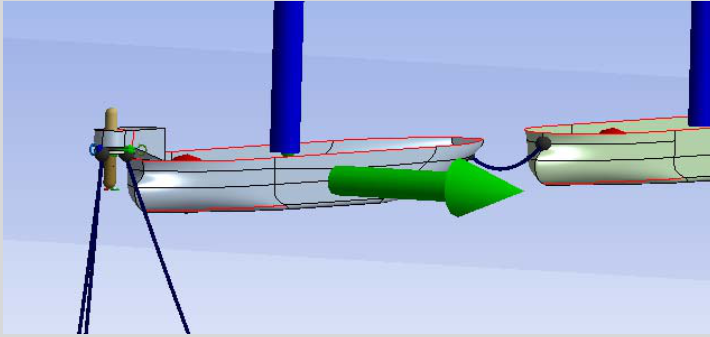-
-
June 9, 2025 at 10:52 am
kingdsystems
Subscriberhi,
Please, I need urgent clarification.
1) How are the structures simulated in tandem or side-by-side as shown in the pictures without one running into the other during the simulation time? This is not my own, but I tried a similar simulation, but as I increased the simulation time during time response analysis, I got an error, and one of the structures ran into the other.
2) How is the articulation for the turret mooring system added as shown in this picture?
I will appreciate it, if someone can make a video of this for me. I am completely lost.
Thanks
-
June 13, 2025 at 9:05 am
Mike Pettit
Ansys EmployeeHello,
Aqwa doesn't automatically detect contact between structures, but you can create Fender connections to model any contact: https://ansyshelp.ansys.com/public/account/secured?returnurl=/Views/Secured/corp/v251/en/wb_aqwa/aqwa_fenders.html
However, I guess the error you're encountering relates to the hydrodynamic interaction between the structures as they move relative to one another in the time domain. In the Hydrodynamic Diffraction analysis the Aqwa solver calculates how much of an effect the presence of one structure has on the motions of the other, and vice versa, due to shielding and wave radiation effects. This interaction effect is only calculated for the structures in their original positions, though, and it is not recalculated in the time domain as the structures move. So, the Aqwa solver stops if it detects that the relative motion is too large, as the results are likely to be inaccurate.
For the articulation (joint) definition, please take a look at the user manual: https://ansyshelp.ansys.com/public/account/secured?returnurl=/Views/Secured/corp/v251/en/wb_aqwa/aqwa_joints.html
Mike
-
June 19, 2025 at 12:14 pm
kingdsystems
SubscriberThanks for your response.
I that case, how can i resolve this "HYDRODYNAMICALLY INTERACTING STRUCTURES HAVE MOVED SIGNIFICANTLY FROM THE ANALYSIS POSITION RESULTS ARE INACCURATE - MOVEMENT EXCEEDS 50%".
I have tried everything i can but to no avail. -
July 15, 2025 at 3:01 pm
Mike Pettit
Ansys EmployeeHello,
The answer to this depends on the relative ship motions in the stability analysis (equilibrium position calculation) and/or the time response analysis.
If the ships are moved relative to one another in the equilibrium position calculation, then you should use Part Transforms (right-click on each ship and Add > Part Transform) to move them closer to their equilibrium positions for the Hydrodynamic Diffraction analysis.
For example: Ship 1 is originally positioned at X = 10 m, Ship 2 is originally positioned at X = 230 m. The equilibrium calculation moves the ships to X = 40 m and X = 190 m, respectively. Add a Part Transform to Ship 1 to move it +30 m in the X direction; similarly for Ship 2 to move it -40 m in the X direction. In this way the definition positions of the ships in the Hydrodynamic Diffraction analysis will be closer to their equilibrium positions, and you are less likely to see warnings related to hydrodynamic interaction in the time domain.
If the ships move relative to one another in the time domain, this is harder to fix. The recommended approach is to create a separate Hydrodynamic Diffraction analysis for the ships in their transient positions, then use a Python pre-solve script to load the hydrodynamic database from this additional Hydrodynamic Diffraction system into a second time domain Hydrodynamic Response system.
For example: Ship 1 is originally positioned at X = 10 m, Ship 2 is originally positioned at X = 230 m, and there is no change in relative position during the equilibrium position calculation. After 3600 seconds of the time response analysis, Ship 1 has moved to X = 40 m and Ship 2 to X = 190 m. To avoid inaccurate time domain results, a separate Hydrodynamic Diffraction analysis is defined, in which Part Transforms are used to move the ships to X = 40 m and X = 190 m respectively. A second time response analysis is linked to the first, with a Start Time of 3600 sec, and a pre-solve script is used to import the hydrodynamic database from the additional Hydrodynamic Diffraction analysis. In this way the hydrodynamic interaction effects are 'updated' for the new ship positions.
I hope this helps!
Mike
-
- You must be logged in to reply to this topic.



-
3492
-
1057
-
1051
-
965
-
942

© 2025 Copyright ANSYS, Inc. All rights reserved.








